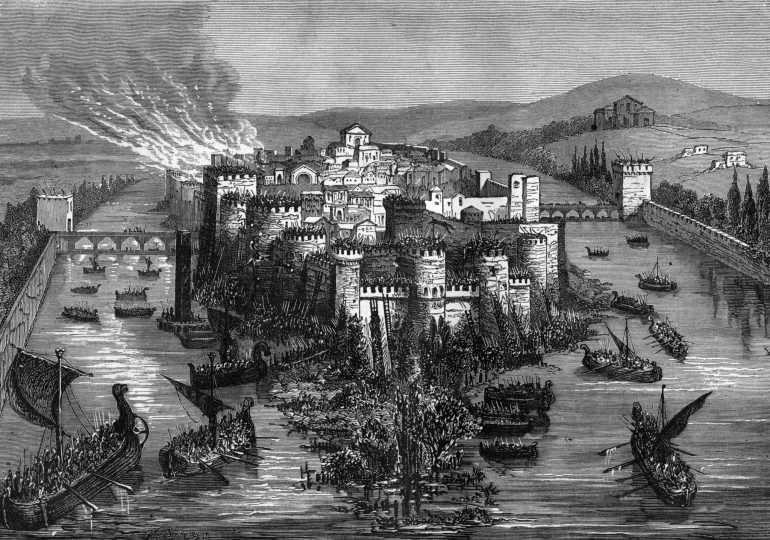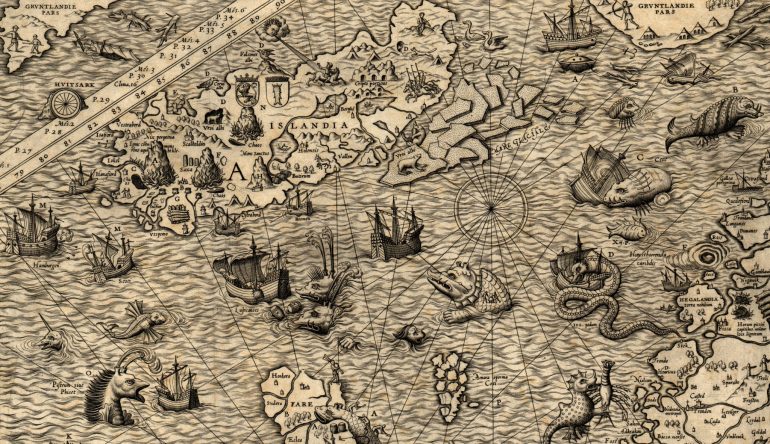Whether fact, fiction or myth, the story of Ragnar Lothbrok is the stuff of legend. History’s most famous Viking wore many crowns: father of the Great Heathen Army, husband to a mythical warrior queen, king of Sweden and Denmark and the scourge of Anglo-Saxon England.
Also known as Ragnarr Lodbruk, his life was immortalised in the famous sagas of Iceland some 350 years after his death. In fact, as Vikings kept almost no written records of their exploits, these 12th and 13th century accounts of the Ragnar Saga are some of the earliest in existence.
Of course, with such a disparity of time between the events and their recordings, ambiguity persists as to what is real and what has been embellished or possibly entirely invented. It may even be that his story is an amalgam of several Viking warriors. Of course, everyone can judge for themselves as we explore the epic tale of King Ragnar Lothbrok.
Ragnarr Lodbruk - The Man, The Myth, The Legend

Antique Map of Iceland (Photo: duncan1890 via Getty Images)
Very little, if anything at all, is known of Ragnarr Lodbruk’s early years. It is said he was the son of Swedish King Sigurd Ring and Princess Alfhild and may have been born in the early years of the 9th century, around 815 AD. According to an obscure Icelandic text called Fragment of a Saga about Certain Ancient Kings, Ragnar was ‘the biggest and fairest of men that human eyes have seen, and he was like his mother in appearance and took after her kin.’
He is believed to have had at least three wives. The first was the famed shield maiden Lagertha. She was followed by Thora Borgarhjört, whose affections he won by saving her from a giant snake. The third was named Aslaug, although she was referred to as Kraka or Kraba in the Icelandic sagas. One 12th century work by Christian Danish chronicler Saxo Grammaticus mentions a fourth wife, but is the sole source to do so.
It was his third wife who bore him the equally legendary Vikings Ivar the Boneless, Bjorn Ironside and Sigurd Snake-in-the-eye. They would go on to lead the Great Heathen Army that invaded England in 865 AD.
In the years after Ragnar Lothbrok died, many Vikings claimed to be his direct descendents and took the name Ragnarsson, if only to appear more intimidating.
Perhaps the most compelling piece of evidence to suggest this Viking hero Ragnar was a real person wasn’t from a Scandinavian text at all, but from The Anglo-Saxon Chronicle. It is an English text widely accepted to be one of the more reliable documents from the 9th century. It mentions a prominent Viking raider known as Ragnall and Reginherus, both of whom are believed to refer to Ragnar Lothbrok.
Ragnar: Viking Hero

Siege of Paris by Norsemen in 845 (Photo: Apic via Getty Images)
If the sagas are to be believed, Ragnarr Lodbruk was known for the brutality of his method of attack. It has been described as swift, devastating and overwhelming, robbing his adversaries of any time to gather their forces. He was said to be a master strategist who would only fight when the odds were overwhelmingly in his favour.
Whilst Ragnar was certainly not the first viking to raid England and Scotland, he may have been the first to create settlements where he raided. This was in an attempt to seize and control areas of land rather than just pillage and move on.
The Siege of Paris
The Icelandic sagas mention various raids in England and throughout northern Europe, but mostly focused on his family. There were Danish accounts however and these were predominantly a catalogue of successful Viking invasions. Perhaps the most famous of these was the Siege of Paris.
In around 845, an armada said to have been led by Ragnarr Lodbruk of 120 ships and carrying over 5,000 men and women sailed up the Seine. It was the culmination of a devastating invasion of West Francia, now the western half of France. The Viking army defeated Frankish king Charles the Bald’s modest army and went on to plunder and occupy Paris. They only withdrew after the king paid Ragnar and his army 2,500kg of gold and silver.
King Ragnar Lothbrok

Sweden and Denmark antique map (Photo: SergeyMikhaylov via Getty Images)
While he was referred to as a king, particularly of Sweden and Denmark, there is very little evidence to suggest King Ragnar Lothbrok ever sat on a throne in the sense we understand. For example, although Grammaticus called him a Danish king, he may only have ruled over a specific area rather than the whole nation.
The Death of Ragnar the Viking Hero

King Edmund I (Photo: duncan1890 via Getty Images)
Most sources which tell his tale agree that Ragnar died in England in around 860 AD. One version of the story suggests he was captured during a raid by Anglo-Saxon King Ælla in Northumberland and thrown into a pit of snakes. Another says he was murdered somewhere in East Anglia after befriending King Edmund.
A less popular tale of Ragnar’s death was that he was shipwrecked somewhere in the Irish Sea when his raiding party was caught in a violent storm.
Ragnar’s Legacy

Viking ships on the water under the sunlight (Photo: vlastas via Getty Images)
Ragnar’s sons would carry his legacy, each becoming famous in his own right. It is said that it was his death that prompted the trio to rouse the Great Heathen Army and form a unified front with other Vikings. They landed in East Anglia in 865 AD, leading to almost two centuries of Norse occupation in the east and north of England.
Debate and doubt rages on to this day about his true existence. Separating fact from fiction is all but impossible. Yet what we know about Ragnar, saga, truth or myth, is that he earned his place as one of history’s most brutal, successful and fearless warriors.












